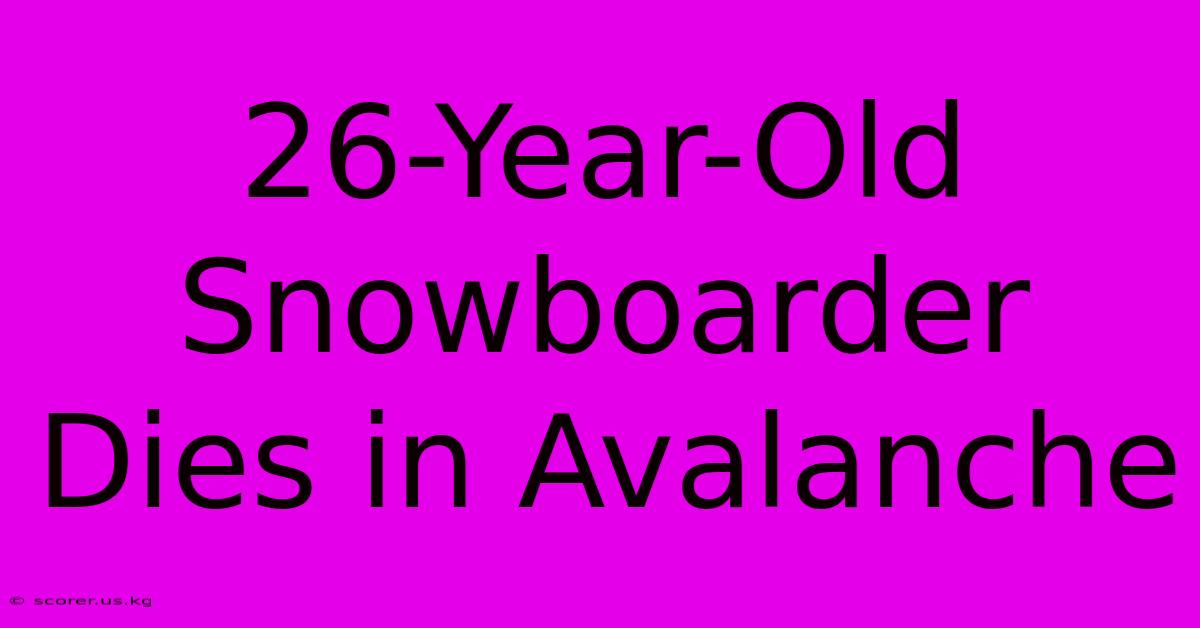26-Year-Old Snowboarder Dies In Avalanche

Discover more detailed and exciting information on our website. Click the link below to start your adventure: Visit Best Website scorer.us.kg. Don't miss out!
Table of Contents
26-Year-Old Snowboarder Dies in Avalanche: A Tragic Reminder of Backcountry Risks
A devastating tragedy struck the snowboarding community this week with the death of a 26-year-old snowboarder in an avalanche. This heartbreaking incident serves as a stark reminder of the inherent dangers of backcountry snowboarding and the importance of avalanche safety education and preparedness.
The Incident: A Devastating Loss
The young snowboarder, whose name has been withheld pending notification of next of kin, was reportedly snowboarding in [Location of Avalanche - be specific if known, otherwise say a general area like "the backcountry near Whistler"] when the avalanche occurred. Initial reports suggest [brief, factual description of the incident based on available information, avoiding speculation]. Rescue teams were dispatched, but sadly, the snowboarder was found deceased.
The Impact on the Community
The snowboarding community is mourning the loss of this talented and passionate individual. Tributes are pouring in on social media, highlighting the victim's skills, positive attitude, and love for the sport. This tragedy underscores the deep connection that exists within the snowboarding community and the profound impact that such losses can have.
Understanding Avalanche Safety
Avalanches are a serious and unpredictable threat in mountainous regions. Understanding the factors that contribute to avalanches and practicing safe backcountry techniques are crucial for minimizing risk.
Key Factors Contributing to Avalanches:
- Snowpack Instability: The structure of the snowpack plays a critical role. Weak layers within the snowpack can create instability, leading to avalanches when triggered.
- Slope Angle: Steeper slopes are significantly more prone to avalanches. Slopes exceeding 30 degrees pose a considerable risk.
- Recent Weather: Fresh snowfall, rapid temperature changes, and wind can all destabilize the snowpack.
- Human Triggering: Skiers and snowboarders can inadvertently trigger avalanches, even on slopes that appear stable.
Essential Avalanche Safety Practices:
- Education and Training: Take an avalanche safety course from a reputable provider. Learn to assess avalanche risk, use avalanche safety equipment, and make informed decisions in the backcountry.
- Avalanche Safety Gear: Always carry and know how to use an avalanche transceiver, probe, and shovel.
- Check the Avalanche Forecast: Consult the local avalanche forecast before heading into the backcountry. This provides crucial information about avalanche risk levels.
- Travel in Groups: Never snowboard alone in the backcountry. Travel with partners and communicate regularly.
- Plan Your Trip: Inform someone of your plans, including your route and expected return time.
- Observe Snow Conditions: Pay close attention to the snowpack and look for signs of instability.
- Avoid High-Risk Areas: Stay away from slopes that appear unstable or have avalanche signs.
Beyond the Tragedy: A Call for Responsible Backcountry Recreation
The death of this young snowboarder is a somber reminder that backcountry snowboarding, while incredibly rewarding, carries significant risks. This tragedy should not deter people from enjoying the sport, but it should underscore the absolute necessity of responsible practices and thorough preparation. By prioritizing education, utilizing proper equipment, and respecting the power of nature, we can strive to make the backcountry a safer place for everyone.
Keywords: avalanche, snowboarding, backcountry, avalanche safety, snow safety, winter sports, safety tips, avalanche training, avalanche forecast, snowpack, slope angle, accident, tragedy, mountain safety, winter recreation, outdoor safety, risk assessment, avalanche transceiver, probe, shovel.

Thank you for visiting our website wich cover about 26-Year-Old Snowboarder Dies In Avalanche. We hope the information provided has been useful to you. Feel free to contact us if you have any questions or need further assistance. See you next time and dont miss to bookmark.
Featured Posts
-
Avalanche Claims Olympic Snowboarder Hediger
Dec 25, 2024
-
26 Year Old Snowboarder Dies In Avalanche
Dec 25, 2024
-
Mc Donald S Starbucks Dunkin Christmas Hours
Dec 25, 2024
-
Dunkin Starbucks Mc Donalds Open On Christmas
Dec 25, 2024
-
Atlanta Airport Resumes Operations After American Delay
Dec 25, 2024
